Blank B.E., Krantz S.G. Calculus: Single Variable
Подождите немного. Документ загружается.


continued to watch it until it faded from his sight on
February 11, 1801. Piazzi had tracked it for 41 nights
over an arc of only 3
. In June of 1801, he published his
observations, but they did not help other astronomers
relocate the object, which was thought to be the
undiscovered planet predicted by Bode’s law.
Where astronomers with telescopes failed, Gauss
succeeded, using mathematics alone. In particular, Gauss
applied a mathematical tool of his own invention—the
Method of Least Squares. On December 7, 1801, the first
clear viewing night after Piazzi’s object emerged from
the shadow of the sun, it was spotted exactly where
Gauss had predicted it would be. As Gauss remarked,
“the fugitive was restored to observation.” (Piazzi’s
object, however, turned out to be only an asteroid, and
Bode’s law is now known to be invalid.)
Many descendants of Gauss are scattered across the
United States. The two youngest of his four sons,
Eugen and Wilhelm, emigrated to the United States.
Writing from New York City in 1831, Eugen informed
his father that “Your na me is well known even he re in
this wilderness.” Eugen’s army enlistment took him to
Fort Snelling, Minnesota, where he served under the
command of future president General Zachary Taylor.
He settled in St. Charles, Missouri, where the house
that he built still stands.
Genesis & Development 535
This page intentionally left blank

CHAPTER 7
Applications of
the Integral
There is a common philosophical thread that runs through the first five sections of
this chapter. Namely, in each of these sections, we introduce certain physical
quantities. We approximate these quantities in a plausible way by a mathematical
procedure that leads to a Riemann sum. By letting the subinterval lengths that
appear in the sum tend to 0, we are in each case led to an integral. We then declare
that integral to, in fact, represent the physical quantity that we started out to
analyze. What gives us the right to do this?
There is a good pract ical answer. In each of the instances discussed in this
chapter, the mathematical model for the physical quantity being discussed gives the
same measurement in practical examples as one or more independent methods. For
instance, we develop several mathematical formulas for the volumes of solids of
revolution. When applied to calculate the volume inside a sphere, the formula
generates the same an swer as can be obtained by immersing a sphere in water and
measuring the displacement. We also develop a formula for the length of a curve.
In practice, this formula gives the same answers as one obtains when measuring the
length of the same curves with a tape measure. Similar comments apply to the other
physical quantities—work and center of mass—which are discussed here.
When applying mathematics, it is always important to have objective methods
for testing the validity of the mathematical models. Scientists are constantly
challenging, checking, and revising their methods for modeling. This is a crucial
step in the advancement of scientific knowled ge.
In the last two sect ions of this chapter, you learn methods that enable you to
determine an unknown function y(x) from information about its rate of change. In
these applications, the star ting point is a model for the derivative of the function.
We deduce or obs erve an equation involving x, y(x), and y
0
(x). Such a relationship
is called a differential equation. The integral is then used to solve the differential
equation and find a formula for the function itself. Solving differential equations
constitutes one of the most important applications of calculus. For many students, a
specialized course in differential equations is the natural continuation of thei r
calculus studies.
PREVIEW
537
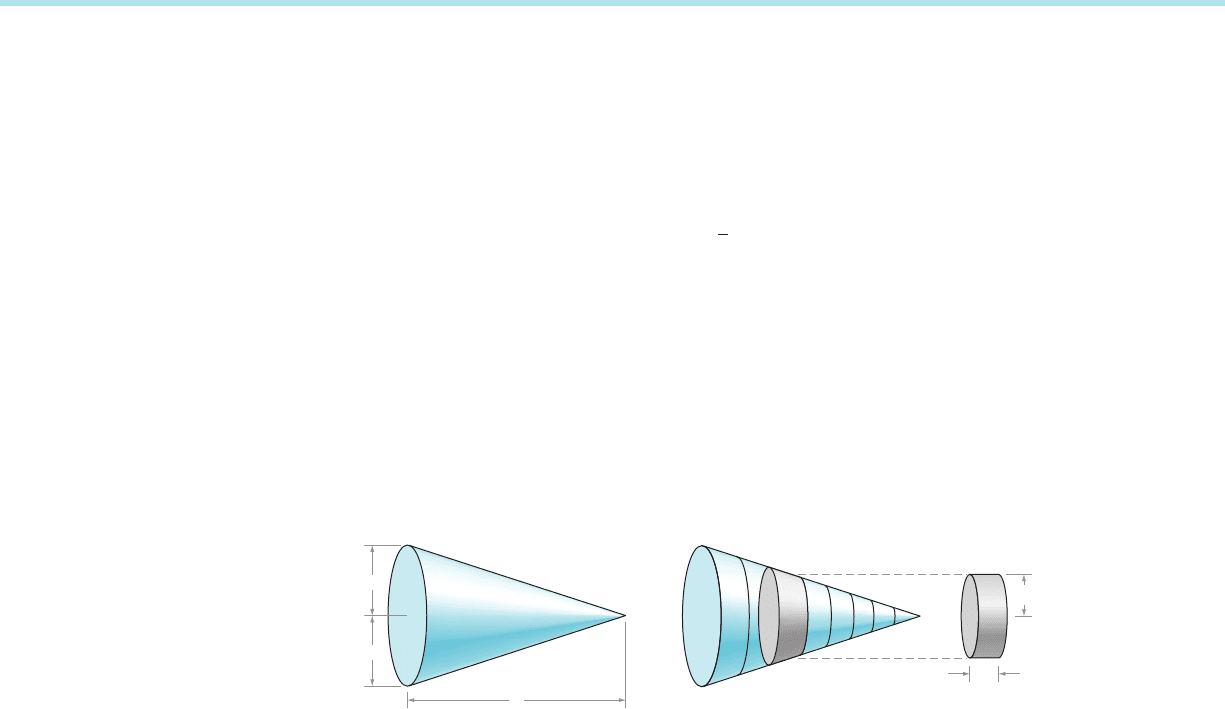
7.1 Volumes
In this section, we will think about volume in much the same way that we thought
about area in Chapter 5. That is, we will be calculating the volume of a solid by
cutting up the solid into elementary piece s.
Volumes by Slicing—
The Method of Disks
You may have already learned that
V 5
1
3
πr
2
h ð7:1:1Þ
is the formula for the volume V of a right circular cone of height h and radius r
(Figure 1). Let us see for ourselves how we can deduce this formula. We begin by
slicing up the cone into N equally thick pieces as in Figure 2. The volume of each
slice is approximately equal to the volume of a disk—see Figure 2. If the j
th
disk has
radius r
j
and thickness Δx, then its volume is the product (πr
j
2
) Δx of its cross-
sectional area πr
j
2
and its thickness Δx. To obtain an approximation to the volume
of the cone, we add up the volumes of the disks:
X
N
j 5 1
πr
2
j
Δx: ð7:1:2Þ
To get a better approximation, we make the disks thinner by increasing the value of
N. To get the precise volume V, we let the thickness of the disks tend to 0 by letting
N tend to infinity:
V 5 lim
N-N
X
N
j51
πr
2
j
Δx: ð7:1:3Þ
To compute this limit, we identify expression (7.1.2) as a Riemann sum. Then
formula (7.1.3) expresses the volume of the cone as a limit of Riemann sums—that
is to say, an integral (as you learned in Chapter 5). Example 1 provides the details
of the technique just described.
⁄ EX
AMPLE 1 Calculate the volume V of a right circular cone that has
height 11 and base of radius 5.
Solution Figure
3 depicts the xy-plane and the cone in question. The cone is
positioned so that the x-axis is its axis of symmetry, and the origin is the center of its
base. The line segment that is formed by the intersection of the edge of the cone
r
r
h
m Figure 1
r
j
jth slice
x
m Figure 2 A disk is used to approximate a slice
of the cone.
538 Chapter 7 Applications of the Integral

and the xy-plane has slope 25/11 and y -intercept (0, 5) . Its equation is therefore
y 525x/11 1 5.
In Figure 3, we have partitioned the interval [0, 11] into N subint
ervals of equal
length Δx. For each j from 1 to N, a point s
j
is chosen in the j
th
subinterval.
(Because the particular value of s
j
will not matter, a formula for s
j
is not needed.)
As Figure 3 indicates, we approximate the j
th
slice by means of a disk of thickness
Δx and radius r
j
equal to the vertical distance from the point (s
j
, 0) to the edge of
the cone. The approximating sum (7.1.2) becomes
X
N
j51
π
25s
j
11
1 5
2
Δx: ð7:1:4Þ
As N increases and Δx becomes smaller, this sum gives a more accurate approx-
imation to the desired volume; however, expression (7.1.4) is also a Riemann sum
for the integral
Z
11
0
π
25x
11
1 5
2
dx: ð7:1:5Þ
Thus both the volume V of the cone and the integral (7.1.5) are equal to the
limit of sum (7.1.4) as N tends to infinity. We conclude that V is equal to
Z
11
0
π
25x
11
1 5
2
dx 5 π
5
11
2
Z
11
0
ð2x 1 11Þ
2
dx 5 π
5
11
2
ð2x 1 11Þ
3
23
11
0
5 π
5
11
2
0
23
2
11
3
23
5
1
3
π 5
2
11: ¥
INSIGHT
In Example 1, if we replace each occurrence of 5 with r and each 11 with h,
then formula (7.1.5) becomes
Z
h
0
π
2rx
h
1 r
2
dx, and we find that the volume of the
right circular cone with base r and height h is
V 5
Z
h
0
π
2rx
h
1 r
2
dx 5 π
r
h
2
Z
h
0
ð2x 1 hÞ
2
dx 52
1
3
π
r
h
2
ð2x 1 hÞ
3
x5h
x50
5
1
3
πr
2
h;
as given in formula (7.1.1).
y 5
5x
11
r
j
s
j
5
5
11
jth slice
y
x
5
11
s
j
x
m Figure 3
7.1 Volumes 539
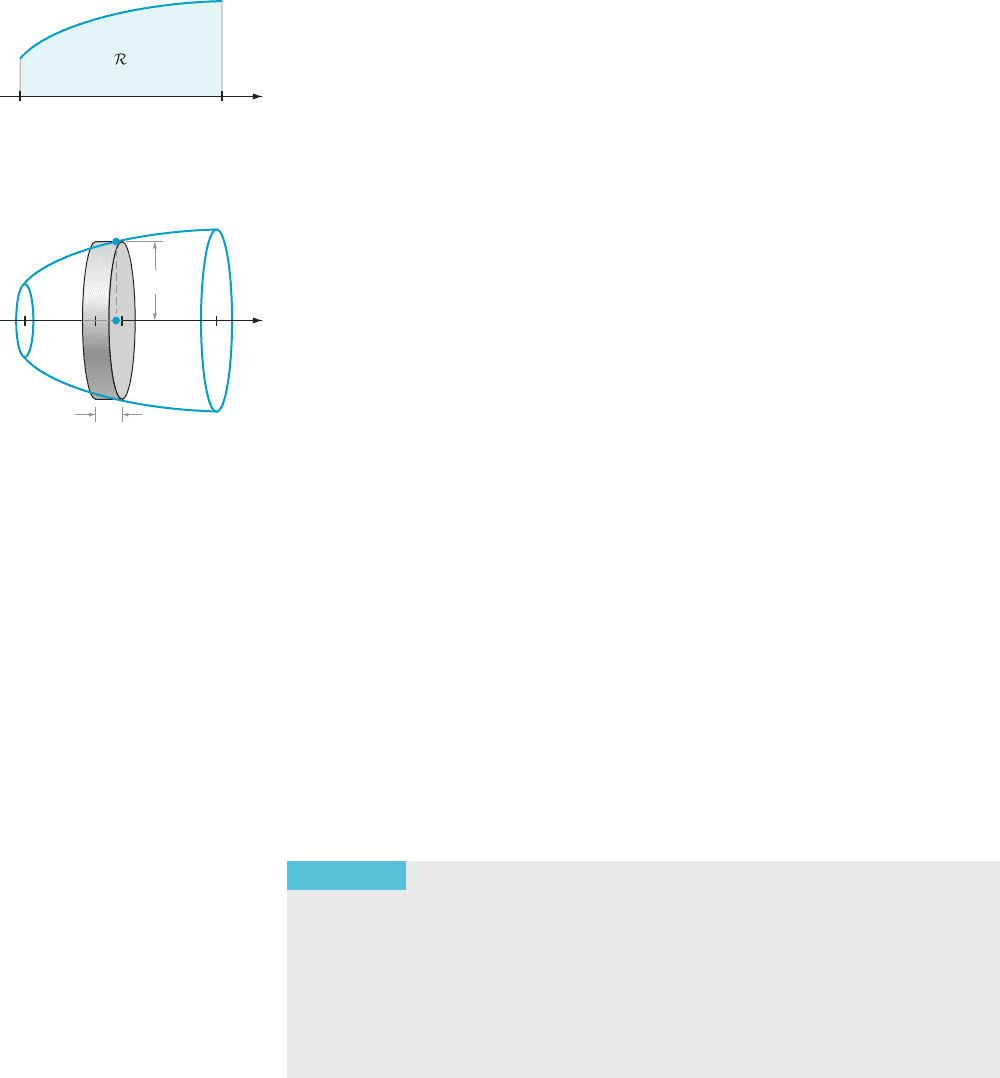
Solids of Revolution With little modification, the method that we have developed for the cone can be
used to find the volumes of other solids. Glance again at Figure 3. The key step is to
recognize that, if R is the region in the xy-plane that lies below the graph of
y 525x/11 1 5 and above the interval [0, 11], then the solid cone can be generated
by rotating R about the x-axis. In general, a solid that is obtained by rotating a
figure in the xy-pla ne about a line in the xy-plane is called a solid of revolution.
Consider, for example, a nonnegative continuous function f that is defined on
an interval [a, b]ofthex-axis. The graph of f, the x-axis, and the vertical lines x 5 a
and x 5 b bound a region R in the plane, as shown in Figure 4. Let us see how to
calculate the volume of the solid of revolution that is generated by rotating the
planar region R about the x-axis.
As before, we partition the interval [a, b] into N subinterval s of equal length
Δx. For each j from 1 to N, we choose a point s
j
in the j
th
subinterval. Figure 5
indicates that we approximate the j
th
slice of the solid of revolution with a disk of
radius f ( s
j
) and thickness Δx. The contribution to volum e from this disk is the
product of its cross-sectional area and thickness, or (π f (s
j
)
2
) Δx. The sum of the
volumes of the N disks is
X
N
j51
π f ðs
j
Þ
2
Δx:
As we let N tend to infinity, the union of the approximating disks becomes closer to
the solid of revolution. We therefore define the volume V of the solid of revolution
to be
V 5 lim
N-N
X
N
j51
π f ðs
j
Þ
2
Δx:
Notice that the expression in this limit is a Riemann sum for the integral
Z
b
a
π f ðxÞ
2
dx:
Because
Z
b
a
π f ðxÞ
2
dx 5 lim
N-N
X
N
j51
π f ðs
j
Þ
2
Δx;
we see that the volume of the solid of revolution is represented by a Riemann
integral. We may state our conclusion as a theorem.
THEOREM 1
(Method of Disks: Rotation About the x-Axis) Suppose that f is a
nonnegative, continuous function on the interval [a, b]. Let R denote the region
of the xy-plane that is bounded above by the graph of f, below by the x-axis, on
the left by the vertical line x 5 a, and on the right by the vertical line x 5 b. Then,
the volume V of the solid obtained by rotating R about the x-axis is given by
V 5 π
Z
b
a
f ðxÞ
2
dx:
ba
y f(x)
x
m Figure 4
(s
j
, f(s
j
))
f(s
j
)
s
j
x
x
y f(x)
a
b
m Figure 5
540 Chapter
7 Applications of the Integral

⁄ EXAMPLE 2 Calculate the volume of the solid of revolution that is gen-
erated by rotating about the x-axis the region of the xy-plane that is bounded by
y 5 x
2
, y 5 0, x 5 1, and x 5 3.
Solution Figure
6 shows the region to be revolved as well as the solid of revolution.
According to Theorem 1, the volume of this solid is
V 5 π
Z
3
1
ðx
2
Þ
2
dx 5 π
Z
3
1
x
4
dx 5 π
x
5
5
x53
x51
5 π
3
5
2 1
5
5
242
5
π: ¥
In some problems, it is useful to think of the curve as x 5 g( y)
and to rotate
about the y-axis (see Figure 7). Reasoning similar to Theorem 1 gives the follo wing
result for the volume of the solid that is obtained when an arc of the curve x 5 g( y)
is rotated about the y-axis.
THEOREM 2
(Method of Disks: Rotation About the y-axis) Suppose that g(y)
is a nonnegative continuous function on the interval c # y # d. Let R denote the
region of the xy-plane that is bounded by the graph of x 5 g(y), the y -axis, and
the horizontal lines y 5 c and y 5 d. Then the volume V of the solid obtained by
rotating R about the y-axis is given by
V 5 π
Z
d
c
gðyÞ
2
dy:
⁄ EX
AMPLE 3 Calculate the volume enclosed when the graph of y 5 x
3
,
2 # x # 4, is rotated about the y-axis.
Solution Refer
to Figure 8. Because we are rotating about the y-axis, we want to
use Theorem 2. Therefore we express x as a function of y:
x 5 gðy Þ5 y
1=3
:
y x
2
y
1
3
x
y x
2
y
x
m Figure 6
y
d
c
x g(y)
x
x
y
m Figure 7 The planar region R and the solid that R
generates when rotated about the y-axis
2
y
x
y
13
y
4
(2, 8)
(4, 64)
64
8
y x
3
or
x g(y)
y
1/3
m Figure 8
7.1 Volumes 541
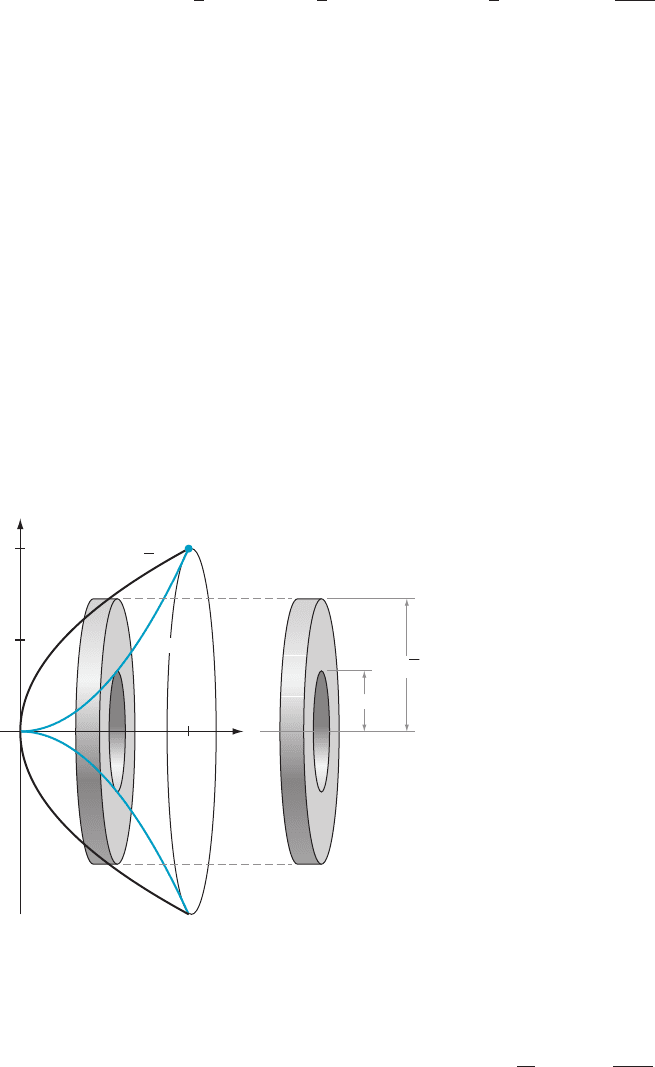
Notice that x 5 2 corresponds to y 5 8, and x 5 4 corresponds to y 5 64. Then,
according to Theorem 2, the desired volume is
V 5 π
Z
64
8
ðy
1=3
Þ
2
dy 5
3
5
πy
5=3
y564
y58
5
3
5
π
64
5=3
2 8
5=3
5
3
5
πð4
5
2 2
5
Þ5
2976
5
π: ¥
The Method of
Washers
Sometimes we want to generate a solid of revolution by rotating the region between
two graphs. Here is an example.
⁄ EX
AMPLE 4 Let D be the region of the xy-plane that is bounded above by
y 5 8
ffiffiffi
x
p
and below by y 5 x
2
. Calculate the volume of the solid of revolution that is
generated when D is rotated about the x-axis.
Solution When
we decompose this solid of revolution into thin slices, we obtain
pieces that are approximately was hers, not disks (Figure 9). To approximate the
solid, we use washers that correspond to values of x from x 5 0tox 5 4—these
values are found by solving the equation 8
ffiffiffi
x
p
5 x
2
. The outer radius of the washer
located at x is 8
ffiffiffi
x
p
while the inner radius is x
2
(see Figure 9). The volume
contribution of this washer is obtained by multiplying the area between the circles
by the thickness of the washer:
πð8
ffiffi
ffi
x
p
Þ
2
2 πðx
2
Þ
2
Δx:
Therefore the volume of the solid is
π
Z
4
0
ð8
ffiffiffi
x
p
Þ
2
2 ðx
2
Þ
2
dx 5 π
Z
4
0
ð64x 2 x
4
Þdx 5 π
32x
2
2
x
5
5
x54
x50
5
1536
5
π: ¥
16
(4, 16)
8
4
x
xx
xx
y
y x
2
x
2
8
x
y
8
x
m Figure 9
542 Chapter
7 Applications of the Integral
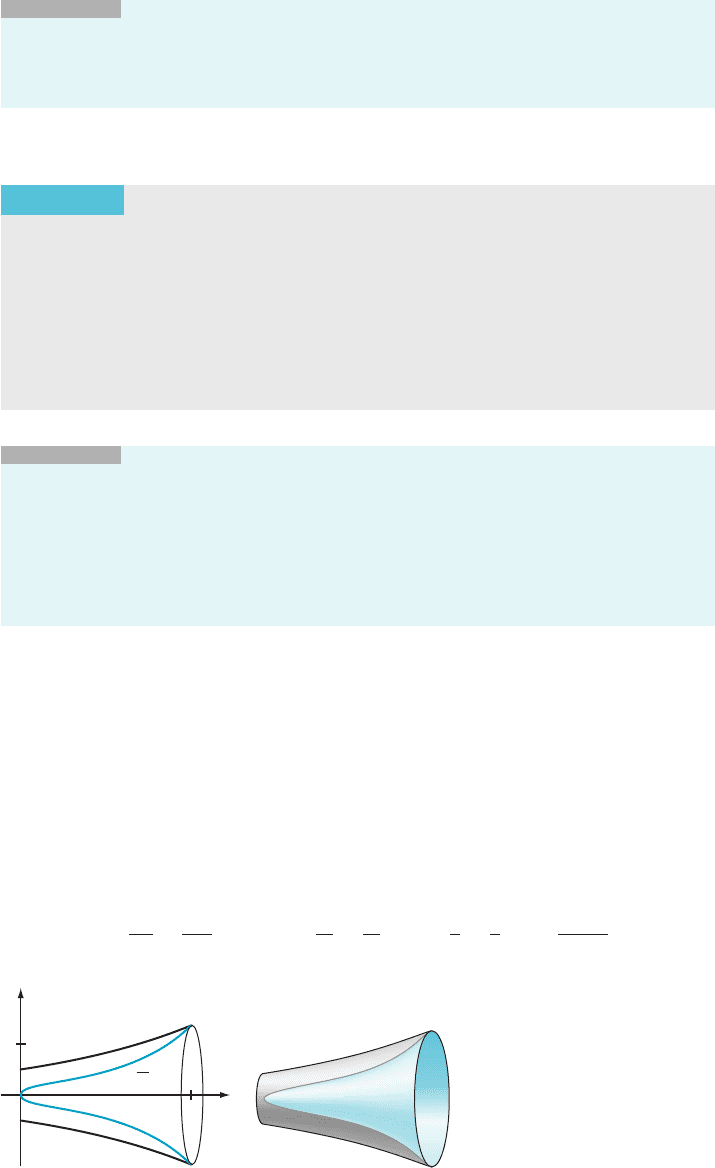
INSIGHT
Notice that it would have been an error in Example 4 to use Theorem 1
with the function f ðxÞ5 8
ffiffiffi
x
p
2 x
2
. This is because we find the area between two
circles by subtracting the area inside the smaller circle from the area inside the larger;
we do not do it by subtracting the radii and squaring the difference.
The reasoning of Example 4 may be used to derive the following theorem.
THEOREM 3
(Method of Washers) Suppose that U and L are nonnegative,
continuous functions on the interval [a, b] with L(x) # U(x)foreachx in this
interval. Let R denote the region of the xy-plane that is bounded above by the
graph of U, below by the graph of L, and on the sides by the vertical lines x 5 a
and x 5 b. Then the volume V of the solid obtained by rotating R about the x-axis
is given by
V 5 π
Z
b
a
UðxÞ
2
2 LðxÞ
2
dx: ð7:1:6Þ
INSIGHT
Equation (7.1.6) may be written as
V 5 π
Z
b
a
UðxÞ
2
dx 2 π
Z
b
a
LðxÞ
2
dx:
This formula is to be expected because we can obtain the solid of Theorem 3 by first
rotating the region under the graph of y 5 U(x) and then removing the solid that is
obtained by rotating the region under the graph of y 5 L(x).
⁄ EXAMPLE 5 Let R be the region of the xy-plane that is bounded above by
y 5 e
x
,0# x # 1 and below by y 5
ffiffiffi
x
p
e
x
2
; 0 # x # 1. Calculate the volume of the
solid of revolution that is generated when R is rotated about the x-axis.
Solution The
plots of U(x) 5 e
x
,0# x # 1 and y 5 LðxÞ5
ffiffiffi
x
p
e
x
2
are shown in
Figure 10. To the right of these plots are the surfaces they generate when rotated
about the x-axis. According to Theorem 3, the volume V of the solid bounded by
these surfaces is given by
V 5 π
Z
1
0
Uð x Þ
2
2 LðxÞ
2
dx 5 π
Z
1
0
e
2x
2 xe
2x
2
dx
5 π
e
2x
2
2
e
2x
2
4
x51
x50
5 π
e
2
2
2
e
2
4
2 π
1
2
2
1
4
5 π
e
2
2 1
4
: ¥
1
2
y
x
y e
x
y
x e
x
2
m Figure 10
7.1 Volumes 543
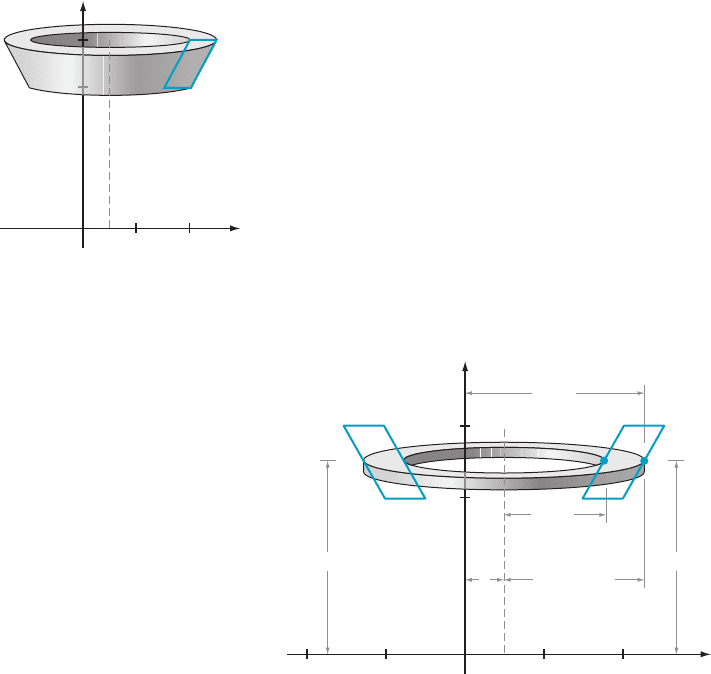
Rotation about a Line
that Is Not a
Coordinate Axis
With only a small modification, the analysis leading to Theorems 1 and 2 can be
applied to calculate the volume of a solid of revolution about a line that is parallel
to (but not equal to) one of the coordinate axes. Here is an example.
⁄ EX
AMPLE 6 Rotate the parallelogram bounded by y 5 3, y 5 4, y 5 x, and
y 5 x 2 1 about the line x 5 1, an d find the resulting volume V.
Solution The
parallelogram and solid of revolution are illustrated in Figure 11. We
approximate the solid by a union of washers corresponding to values of y between 3
and 4. A typical washer at height y is shown in Figure 12. Because y will be the
variable of integration, we must express the volume of this was her in terms of y.
Refer to Figure 12, noting that the distance of the outer edge of the washer to the
y-axis is the x-coordinate of point P. Because point P is on the line y 5 x 2 1, that
coordinate, expressed in terms of y,isy 1 1. From this, we must subtract 1 to find
the dist ance of P to the axis of rotation x 5 1. We conclude that the outer radius of
the washer is (y 1 1) 2 1, or y. Similarly, the inner radius of the washer is 1 unit less
than the x-coordinate of point Q. Expressed in terms of y, the inner radius is y 2 1.
The volume contribution of this washer is therefore
πy
2
2 πðy 2 1Þ
2
Δy:
As before, we su m these volumes and let Δy tend to 0. It follows that
V 5
Z
4
3
πy
2
2 πðy 2 1Þ
2
dy 5 π
Z
4
3
y
2
2 ðy
2
2 2y 1 1Þ
dy
5 π
Z
4
3
ð2y 2 1 Þdy 5 πðy
2
2 yÞ
y54
y53
5 πð16 2 4Þ2 πð9 2 3Þ5 6π: ¥
Now that we have seen severa l instances of calculating volume by the method
of
slicing, it is a good idea to summarize the basic steps that constitute the method .
x
24
y x
y x 1
x 1
y
4
4
3
m Figure 11
4
3
x y
Q
x y 1
y
(y 1) 1
1
P
yy
x
y
y 1
y 1
x 1
2
4
4
2
m Figure 12 Washer at height y
544 Chapter 7 Applications of the Integral
